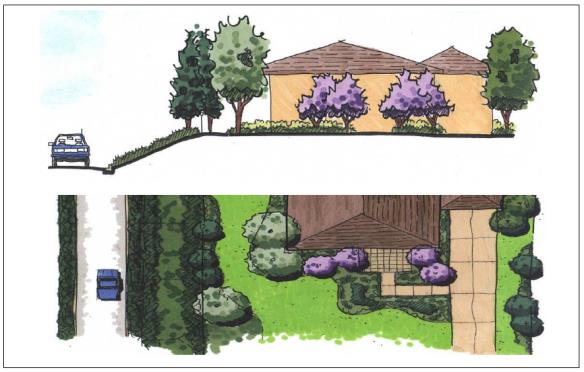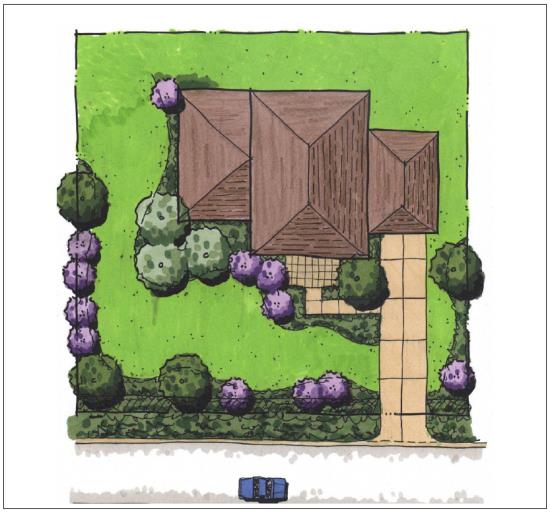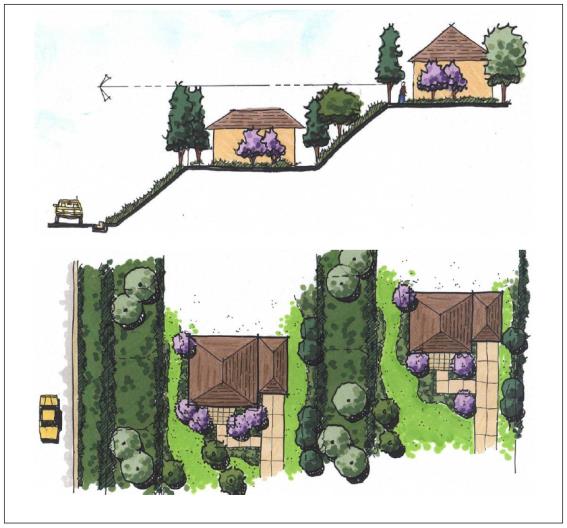Chapter 7.12 Landscaping Standards
7.12.10 Purpose of this Chapter
The purpose of this Chapter is to establish performance standards, development standards and the findings required for the modification of any applicable development standards for landscaping.
7.12.20 Applicability of this Chapter
This Chapter applies to all development in the City of La Habra Heights regardless of the Zone District.
7.12.30 Performance Standards for Landscaping
All new development and modifications of existing structures must adhere to the City’s landscaping performance standards designed to maintain community character, privacy, views and public health and safety.
A. View Enhancement and Protection. All development applications for approval of new residential construction, modifications of existing structures involving fifty (50) percent or more of the existing structure’s floor area, the addition of a second or higher story to an existing residential structure, or an increase of one thousand (1,000) square feet of floor area, must include a landscaping plan submitted as part of the development application. For all other development applications, landscaping plans are required as determined by the Community Development Director to ensure that the visual impact of new structures and modifications to existing structures is softened by providing screening, privacy for adjoining structures, and preservation of the rural appearance of the community. Approved landscape plans shall be monitored to ensure they are implemented. Protected views enjoyed by residents shall be protected from unnecessary/unreasonable obstruction by any new development’s structures or landscape elements.
B. Maintenance of Privacy. Landscaping must be designed, installed, and maintained in such a manner to preserve the privacy of adjacent properties.
C. Reduction of Light Trespass. Landscaping should consist of materials that reduce potential light and glare impacts on adjacent properties.
D. Landscaping on Graded Surfaces. Landscaping shall be adequate to prevent grading-induced erosion and to restore the look of the natural terrain.
E. Landscaping for Screening. Landscaping must be used to screen all retaining and other walls, parking areas, and other hardscape areas. Landscaping shall screen obtrusive structures, provide privacy and soften the impact of new development.
F. Preservation of Significant Trees. Existing significant trees shall be preserved whenever possible.
G. Invasive Plants Prohibited. Invasive plant species listed on the plant palette shall not be allowed on any landscape plan nor planted on any property. A list of such plants is maintained by the Planning Division or the California Native Plant Society. (Ord. 2015-01 §§ 18, 19; Ord. 2009-08 § 1)
7.12.40 Development Standards for Landscaping
The following sections implement the City of La Habra Heights General Plan goals and policies related to landscaping as a means to protect views, privacy, and community and neighborhood character.
A. Landscaping and Irrigation Plan Required. A Landscaping and Irrigation Plan is required for any project that will result in the following: alteration of any yard associated with new construction; modifications of existing structures involving fifty (50) percent or more of the existing structure’s floor area; the addition of a second or higher story to an existing residential structure; or an increase of one thousand (1,000) square feet of floor area. For projects of these types, the plans shall be provided as part of the application package submitted to the City as required by Article 8. The requirement for a Landscaping and Irrigation Plan for all other development projects shall be at the discretion of the Community Development Director, and a Landscape and Irrigation Plan shall not be required if no new or modified landscaping and irrigation is proposed.
B. Minimum Landscaping Requirements. Landscaping that screens the residence and all other structures from the street and neighboring residences must be provided in the front and other yards. Landscaping shall be provided in the following locations:
1. All required setback areas pursuant to the requirements of Chapter 7.11, except where a required setback is occupied by the access portion of a driveway, shall be landscaped.
2. Those areas used for fire control and/or erosion control more than five (5) feet from the edge of pavement of the adjacent streets shall be landscaped and maintained.
C. Landscape Materials. The following requirements are applicable to landscape materials:
1. Plant materials shall not consist of invasive species that will affect natural areas.
2. Plant materials used in any landscaping must conform to Fuel Modification Zone requirements specified in Article 4.
3. Existing on-site natural and/or landscape materials may be integrated into landscaping plans.
4. A plant palette, which is maintained by the Planning Division, shall be used wherever possible.
D. Use of Landscaping for Screening. On-site landscape materials must provide at least fifty percent (50%) screening, as certified by a licensed landscape architect, of all elevations of all structures and fences and retaining walls visible from the street and from other parcels, within five (5) years following completion of the project. The screening of the structures shall not adversely impact the distant views from the neighboring properties, public or private (refer to Exhibits 7-6 and 7-8).
Exhibit 7-6. Use of Landscaping for Screening
E. Arrangement of Shrubs. Shrubs visible from adjacent private and public properties shall be arranged in broad, informal masses to produce a mounded, textured slope surface (refer to Exhibit 7-7).
F. Arrangement of Trees. Tree plantings visible from adjacent private and public properties shall be placed on the property in a random (non-formal) manner in locations where they will be most effective in softening the impact of construction (refer to Exhibit 7-7).
Exhibit 7-7. Arrangement of Trees and Shrubs
G. Protection of Views. Landscape materials must be selected to minimize the obstruction of protected views both at the time of planting and when the landscaping reaches maturity (refer to Exhibit 7-8). The consideration of the expected height and bulk of landscaping at maturity will take into account the selected plants and the City’s climate and growing conditions.

Exhibit 7-8 Landscaping and Obstruction of Significant Views
H. Parking Area Landscaping Requirements. Parking areas in all Zone Districts must be screened from view from adjacent public and private properties including roads.
I. Additional Parking Area Landscaping Requirements for Non-Residential Zones. For all parking lots containing more than ten (10) stalls or with a paved area of more than twenty-five hundred (2,500) square feet, fifteen percent (15) of the total parking area shall be designed, constructed and maintained as landscaped areas. A minimum of three (3) trees per six (6) parking stalls shall be employed in addition to trees required for periphery screening.
J. Landscaping for Erosion Control. All graded areas must be landscaped to control erosion and restore the look of the natural terrain. Landscaping, which may include trees, shrubs, and ground covers, shall be utilized immediately or before the next rainy season after grading to stabilize and hide all graded areas. All landscaping used for erosion control must be maintained and irrigated. Measures other than landscaping may be used for temporary erosion control prior to completion of construction.
K. Fuel Modification Zones. Landscape plans must incorporate Fuel Modification Zone requirements as detailed in Article 4. These requirements are designed to lessen the potential for wildfire and must be maintained at all times.
L. Public Safety. Within the public right-of-way, landscape plans must incorporate a landscape buffer zone for public safety in compliance with Section 4.4.20(D)(3). The Public Works Department may determine a larger buffer zone is required for public safety. (Ord. 2015-01 §§ 20, 21; Ord. 2007-02 § 3)
7.12.50 Tree Preservation
Significant trees, as defined in this section, shall be conserved wherever possible.
A. Identification of Significant Trees. Significant trees include the following:
1. Trees that are at least twenty (20) inches in circumference measured four and one-half (4-1/2) feet above the mean natural grade.
2. Trees with more than one trunk whose combined circumference is at least thirty (30) inches as measured four and one-half (4-1/2) feet above the mean natural grade.
3. Any tree that is visible from grounds or structures off site and either screens structures from view of other properties or is required as part of a landscaping plan.
B. Preservation of Significant Trees During Site Development. Significant trees shall be preserved where reasonably possible during grading, site development or other site work or construction activities.
C. Tree Removal Permit is Required. No significant tree shall be removed or damaged without an approved Tree Removal Permit. Permit application procedures are identified in Article 8. Tree removal in excess of that allowed by this Chapter without permit is subject to legal penalties as specified in Article 4. Up to four (4) non-significant trees or twenty-five (25) percent of the non-significant trees, whichever is less, may be removed in any single year without permit.
D. Tree Replacement. The following tree removal requirements are applicable to all Zone Districts:
1. The site plan and landscape plan for any new development must identify the trees that will be removed as part of the proposed development and indicate the location, size, species, and extent of the replacement trees.
2. The tree replacement shall consist of trees of sufficient number and size so that the neighborhood character, views and privacy are restored or enhanced.
E. Exceptions. The provisions of this section shall not apply under the following conditions:
1. Emergencies caused by trees being in a hazardous or dangerous condition as determined by City personnel.
2. Emergency maintenance by a public utility necessary to protect or maintain an electric power or communication line or other property of a public utility.
3. Repair and maintenance of existing parkways, highways, and streets and/or other public facilities.
4. Routine maintenance intended to ensure the continued health of a tree, including the trimming of branches. (Ord. 2015-01 § 22)
7.12.60 Findings Required for Approval of a Standards Modification for Landscaping
In addition to the General Findings required by Section 7.19.80, the following additional findings must be made for the approval of a Standards Modification.
A. The requested landscaping modification will not result in a nuisance.
B. The requested modification does not result in any change in the Fuel Modification Zone requirements unless approved by the Fire Chief.


